Making Palm Tree Potting Soil
by Phil Bergman
This articles describes workable soils for palm trees and shows the preparation that we use at our nursery. We use it as a “universal soil” on all of the palms we grow. We amend it for certain species but use the formulae below for 90% of the palms. Note, this article is about a potting soil, i.e. a soil to used in pots. It’s not about “garden soil” or soil you’d import to put in large garden areas.
Introduction
Over my more than forty years as a nurseryman, I have surveyed many palm growers to obtain their formulas for potting soil. And, I inquired about their results with their soil. I would like to recap a few of the conclusions drawn at that time, most of which I still agree with today.

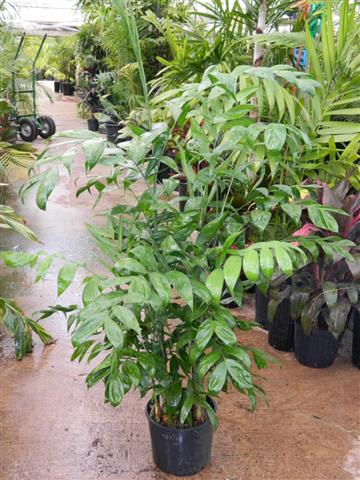
Is There Just One Perfect Palm Potting Soil?
First, there is no single formulae that all growers used. And yet, most growers were growing successfully. Secondly, the soil used depended on what area you were doing your growing. Availability of components varies in regions. It also depended on whether it was for greenhouse or outdoor culture. Finally, it depended upon whether you were growing seedlings or large plants. The one thing that almost everyone had in common was the use of sand. Only one grower used the classical peat moss/perlite combination. I can say after talking to so many others that there is not a perfect, “must contain these things”, type of potting soil. Rather, many soils will work and you have to experiment a bit and see what works for you and your area.
One must also remember that not all palms like the same sort of mix. It would be ludicrous to assume that Brahea armata and Nypa fruticans would like the same soil. Yet, most growers try to use a universal mix for the majority of their palms. This is certainly a practical approach, but not the most scientific one.
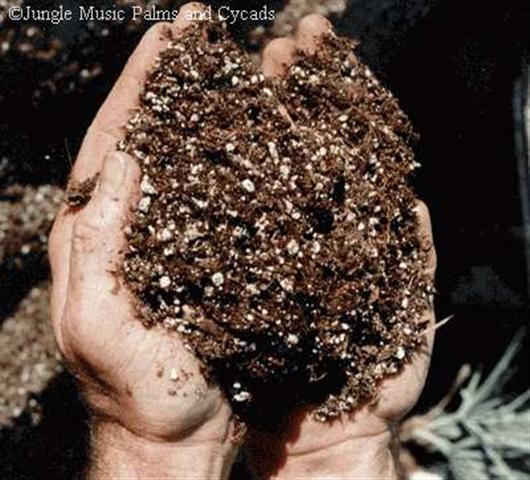
What Should a Potting Soil Do?
A potting soil should offer the plant a substratum for both stability and obtaining its needed water, nutrients and aeration. If a soil is too porous, it will dry out too rapidly and the plant either has to be watered daily or suffer the consequences of desiccation. If it is too dense, it may become waterlogged and lead to rot. Thus, there is an ideal soil that offers drainage but adequate water retention and root support. I like to guarantee good drainage by the usage of perlite, sand, and pumice in my mix. One will find the needed frequency of watering with experience with their soil.
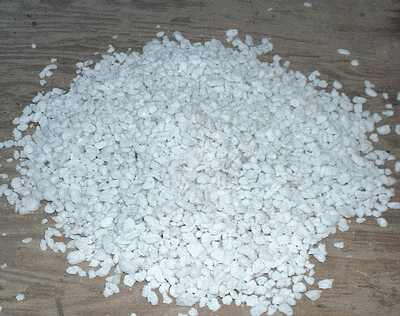
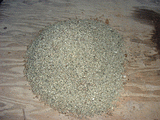
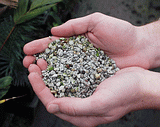
What Should a Good Potting Soil Contain?
As mentioned above every grower has his own formulae for potting soil. Potential components might include:
Topsoil
Bark or wood chips
Shredded organic material including redwood or fir shavings
Perlite
Peat moss
Pumice or lava stone
Sand
Fertilizer (slow release)
Dolomite to balance out excess acidity from organic material
Microelements such as iron, magnesium, manganese, etc.
Below I will describe which of these components above we utilize. As examples, a mix of only topsoil and sand may stay wet for some time and not work for you. A classical a cheap soil would be half peat moss and half perlite. This is probably ok for greenhouse seedlings but doesn’t do well over the long run. Also, the classical Hawaiian mix of lava stone and peat will tend to dry out very quickly and succumb to our dry hot winds in Southern California without frequent watering. As a consumer, a palm grower must try his soil(s), be willing to alter or change them and then come up with what works the best for him. Also, he must know to adjust his watering according to how fast his soil dries out.

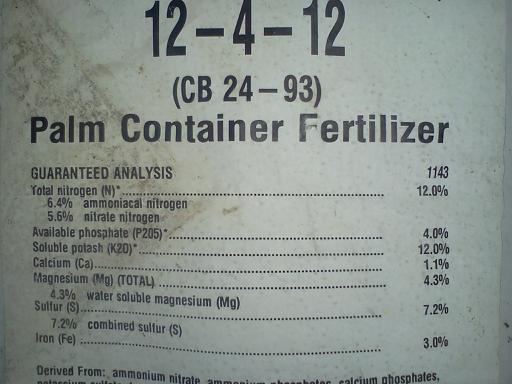
Soil Acidity and Alkalinity
With the usage of peat moss, humus and bark, soils can tend toward being acidic, i.e. a pH lower than 7. These three components result in be on the acidic side. We use dolomite powder to increase the pH. Remember to crush up the rocks you find in the bag. The soil I describe below has a pH of about 6.3 to 6.5. This seems to be acceptable to most palm species, especially the more tropical ones. It is rare indeed that I have to adjust the pH on the soil formulae below to accommodate a particular palm. However, I do use some dolomite in my mix during preparation to offset the very acidic organic material.
If one has alkaline water in their municipality, salts can build up leading to a higher pH. A soil too alkaline can lead to various nutritional problems and microelement deficiencies. Thus, adjust the amount of dolomite to your soil’s pH. You may find, on the contrary, that your soil is too alkaline if which case you may need to add sulfur and certainly not use dolomite.
Availability of the Components to Make Potting Soil
Additionally, a palm grower has to use what is available to him. Every locality has different supplies for making the soil. This gets back to the idea that there are many good potential soils, whether you are using ground up macadamia shells, rice husks, or coconut fiber. You just have to experiment with what’s available and talk to experienced growers. And, you must use what you can acquire in your area. It’s super expensive to have materials shipped to you from out of state.
Commercially Available Potting Soils
Unfortunately, most of the commercially available potting soils are not ideal and certainly not designed specifically for palms. That industry supplying soil has found that the bag must not be too heavy. Women customers are often the ones that visit garden centers and purchase the soil. Because of this, the weight of the bag is important – it must not be too heavy. Important ingredients like sand and topsoil weigh more. So, they are typically left out of the mix. Often one gets a super light mix of only peat moss and perlite. Yes, it is light. But, it is not very good for growing palms. If one is forced to buy such a mix, consider adding topsoil or sand.

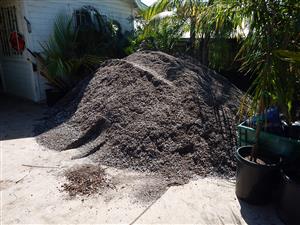
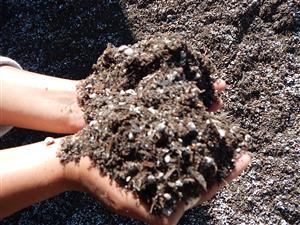
Jungle Music’s Potting Soil for Palms
The potting soil I have been using for many years is below. Over the years we have altered it and changed the formulae a bit, but this would be a representative soil formulae that you could follow.
10% amended topsoil (has about 1/3 high quality topsoil and 2/3 humus)
- 15% pumice #2
- 15% 0 – 1/8 inch pine bark
- 15% nitrolized redwood shavings
- 20% perlite #2
- 10% coarse washed sand, #12
- 15% coarse peat moss
To this formulae above I add per cubic yard: one lb. Dolomite, one lb. Osmocote (14-14-14), and lb. of a microelement mix called Micromax Plus. The entire mixture is turned many times before using. I use about 100 yards of this mix a year and have it professionally mixed in batches of ten to twenty yards each time.
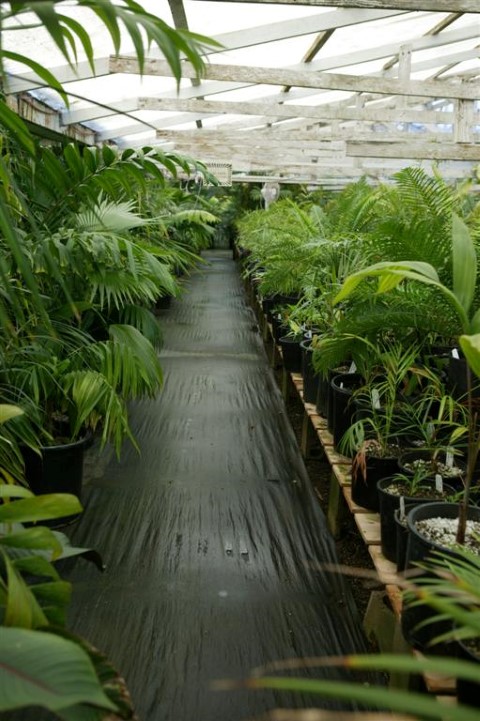
Adjustments to a Potting Soil
For brand new seedlings or very young plants, I may amend this mixture with more redwood shavings and perlite to open it up. Very young plants like good root aeration (lighter soil) and also require more attention and watering. Older plants (2 gallon and larger) seem to thrive in the above mix. For larger plants such as 20 gallon and above, I like to add more topsoil or sand. This keeps the roots well hydrated.
In the greenhouse, I have found that most mixes seem to age quicker, getting more dense and retain more water with age. The same thing happens outdoors but not quite as quickly. The above mix seems to be adequate in most environments for about 2 years. After that point, repotting into a larger pot with fresh mix around the existing root ball is needed.
Remember that new mixes tend to repel water and adequate care must be taken to ensure that the soil is thoroughly and adequately watered during the first watering. Penetrating agents can be used but are not necessary if one waters multiple times on the new mix. My rule is to water at least three times, each time bringing the water to the top of the pot.
The small amount of fertilizer in the mix above is to theoretically offset any nitrogen loss from the large amount of organic material in the mix. It is not meant to replace a regular fertilization program. The microelements I feel are important for overall plant health as very little topsoil is being used. If plants yellow in time in the above mix, I will top-dress with blood meal and this seems to green them up.

Learn Your Soil – Feel It and Get to Know How to Recognize a Good Soil
With time and experience, you will learn which soil is best for your needs and growing conditions. Do feel the soil – recognize it’s weight and composition. As times go on, you’ll be able to just take a hand full of soil and tell instantly if it feels right. Is it heavy enough? Does it contain enough organics? Is it going to drain well? Try doing this and you’ll be amazed how good you get at recognizing a good soil
Do We Sell Our Palm Soil?
When we have it available, we sell our soil in limited amounts by the 15 gallon bag for $12.99. We do not sell large volumes by the yard. Because of soil’s weight, it’s too expensive to ship soil. So, mail order not available. Call for availability for nursery pick up.
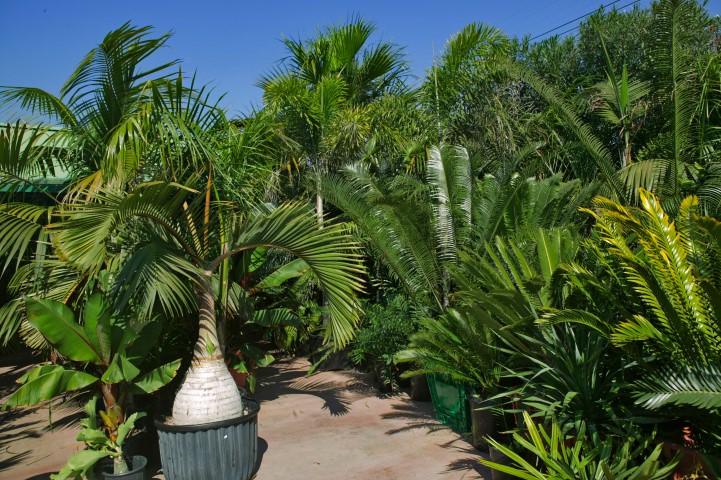
CONCLUSION
Remember, there is no single perfect potting soil. Our formulae above is for potted plants and is not meant to be used as garden soil. For potting soil, that magical and scientifically formulated soil produced by big companies may or may not be best. If one works for you, then it works for you. Be willing to experiment a bit to find the best working soil in your area. Also important is that most palm trees like good drainage and some organic material. You are welcome to try out our mix above. When available, we do sell our soil preparation in bags at the nursery but do not sell it to customers in bulk form. But, my formulae is given above so can buy the components and make your own. Note that the formulae above is soil for containers, not soil to be used in the ground in the garden. For the latter purpose, a different formulae would be used. Feel free to email me if you have any questions.
CLICK TO READ MORE ARTICLES ON PALM TREES
Phil Bergman
Owner and Author
- PALM TREES, CYCADS & TROPICAL PLANT BLOG - October 1, 2020
- TRACHYCARPUS
The Windmill Palm - September 30, 2020 - FAN PALMS –
PALMS WITH CIRCULAR LEAVES - September 29, 2020












